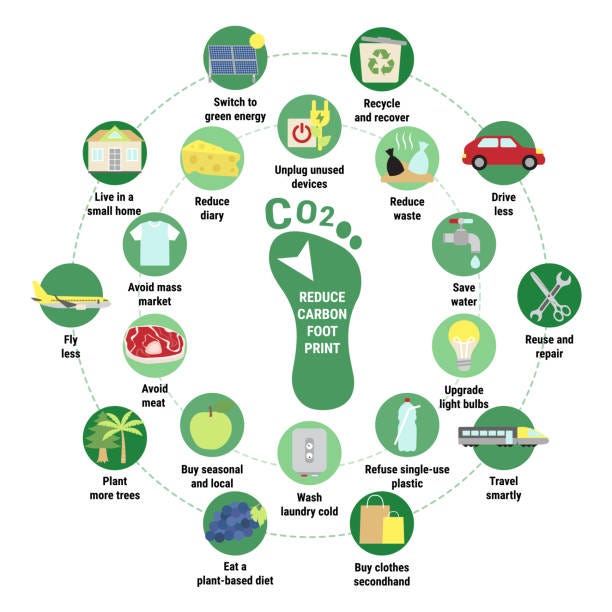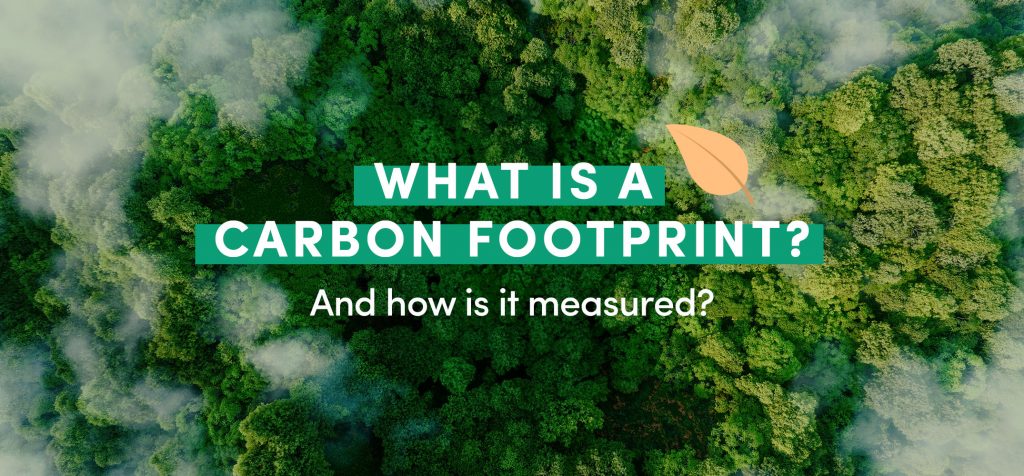A carbon footprint is the total amount of greenhouse gas emissions caused directly and indirectly by an individual, organization, event, product, or service. It’s a measure of the impact human activities have on the environment in terms of the amount of carbon dioxide (CO2) and other greenhouse gases produced and released into the atmosphere.
Reducing our carbon footprint is crucial because greenhouse gas emissions are a major contributor to climate change, which is causing global temperatures to rise, leading to melting glaciers, rising sea levels, more extreme weather events, and other environmental issues. By minimizing our carbon footprint, we can help mitigate the effects of climate change and work towards a more sustainable future.
Individuals, businesses, and governments can take action to reduce their carbon footprint in various areas, such as energy consumption, transportation, waste management, and lifestyle choices. Simple changes like using energy-efficient appliances, driving less, recycling, and reducing meat consumption can make a significant difference. Businesses can implement sustainable practices, use renewable energy sources, and optimize their supply chains. Governments can promote policies and incentives that encourage sustainable practices and invest in clean energy infrastructure.
Table of Contents
Reducing Energy Consumption at Home

Energy-efficient appliances, smart thermostats, and proper home insulation are powerful tools for reducing your carbon footprint by minimizing energy consumption at home. Replacing old, inefficient appliances like refrigerators, washing machines, and air conditioners with Energy Star-certified models can significantly cut down on energy usage. Smart thermostats, which automatically adjust the temperature based on your schedule and preferences, can also lead to substantial energy savings.
Ensuring your home is well-insulated is another crucial step in reducing energy consumption. Proper insulation in the walls, attic, and crawl spaces prevents heated or cooled air from escaping, reducing the workload on your HVAC system and lowering your energy bills. Additionally, sealing air leaks around windows, doors, and other openings can further improve energy efficiency.
Beyond appliances and insulation, simple habits like turning off lights and electronics when not in use, using natural lighting during the day, and adjusting the thermostat a few degrees can collectively make a significant impact on your energy consumption and carbon footprint.
Reducing Carbon Footprint from Transportation
Transportation is a major contributor to carbon emissions, but there are several options available to reduce your carbon footprint in this area. One of the most effective solutions is to switch to an electric vehicle (EV). EVs produce zero direct emissions, and even when accounting for the emissions from electricity generation, they have a significantly lower carbon footprint than gasoline-powered vehicles.
Another option is to utilize public transportation whenever possible. Buses, trains, and subways are more efficient at moving large numbers of people, resulting in lower emissions per passenger compared to individual vehicles. Additionally, many public transit systems are transitioning to electric or hybrid fleets, further reducing their environmental impact.
For shorter distances, consider active modes of transportation such as walking or cycling. These options have zero emissions and offer additional health benefits from increased physical activity. If cycling is not feasible due to distance or terrain, electric bicycles or scooters can provide a low-carbon alternative for commuting or running errands.
Whenever possible, prioritize carpooling or ride-sharing services to reduce the number of vehicles on the road and their associated emissions. Additionally, adopting eco-friendly driving habits, such as avoiding excessive idling, maintaining proper tire pressure, and removing unnecessary weight from your vehicle, can improve fuel efficiency and lower your carbon footprint.
Embrace Renewable Energy Sources
Transitioning to renewable energy sources is a powerful way to reduce your carbon footprint significantly. Solar, wind, and geothermal energy are clean, sustainable alternatives to fossil fuels that can power your home or business without contributing to greenhouse gas emissions.
For homeowners, installing solar panels on your roof or investing in a small wind turbine can help you generate your own clean electricity. Many utility companies also offer renewable energy plans, allowing you to source a portion or all of your electricity from solar, wind, or hydroelectric sources.
Businesses can explore larger-scale renewable energy projects, such as on-site solar farms or wind turbine installations. Alternatively, they can purchase renewable energy credits or participate in community solar programs to support the growth of clean energy infrastructure.
Numerous online resources and government incentives are available to guide individuals and organizations through the process of adopting renewable energy solutions. By embracing these clean technologies, you can significantly reduce your reliance on fossil fuels and make a meaningful impact in mitigating climate change.
Sustainable Food Systems
The food system, encompassing production, processing, transportation, and consumption, contributes significantly to global greenhouse gas emissions. Adopting sustainable practices in agriculture and minimizing food waste can substantially reduce our carbon footprint. Tools and strategies to achieve this include:
- Supporting local and organic farming methods that prioritize soil health, biodiversity, and minimal use of synthetic fertilizers and pesticides. Community-supported agriculture (CSA) programs and farmers’ markets facilitate access to locally grown, seasonal produce.
- Embracing plant-rich diets by incorporating more fruits, vegetables, whole grains, and plant-based proteins, which generally have a lower carbon footprint compared to animal-based products, especially those from industrial livestock operations.
- Implementing efficient irrigation techniques, such as drip irrigation and rainwater harvesting, to conserve water resources and reduce energy consumption associated with water pumping and distribution.
- Utilizing renewable energy sources, like solar and wind power, on farms and in food processing facilities to minimize reliance on fossil fuels.
- Composting organic waste from households and commercial establishments, diverting it from landfills where it would release methane, a potent greenhouse gas. Composting enriches soil fertility and reduces the need for synthetic fertilizers.
- Advocating for policies that incentivize sustainable farming practices, support small-scale farmers, and promote food waste reduction through education, improved infrastructure, and innovative solutions like food rescue programs.
By embracing these tools and strategies, we can transform our food systems into more sustainable and climate-friendly models, reducing our carbon footprint while ensuring food security and environmental stewardship.
Reducing Waste and Promoting a Circular Economy
Minimizing waste and embracing a circular economy are crucial steps in lowering our carbon footprint. By rethinking our consumption patterns and adopting sustainable practices, we can significantly reduce the strain on natural resources and the environment.
One effective tool is to prioritize products and services that generate less waste throughout their lifecycle. This involves choosing items with minimal packaging, opting for reusable or refillable options, and favoring products made from recycled or sustainable materials. Additionally, supporting businesses that offer repair services or take-back programs can extend the lifespan of products and prevent unnecessary waste.
Increasing recycling rates is another powerful strategy. Proper waste segregation and participation in local recycling programs can divert a substantial amount of materials from landfills, reducing methane emissions and conserving natural resources. Moreover, composting organic waste can transform it into nutrient-rich soil, supporting sustainable agriculture and reducing the need for chemical fertilizers.
Embracing a sharing economy can also contribute to waste reduction. Platforms that facilitate the sharing, renting, or borrowing of goods and services can minimize the need for individual ownership, thereby reducing the demand for new products and the associated environmental impact.
Furthermore, supporting initiatives that promote a circular economy is vital. This approach involves designing products and systems that minimize waste and enable the continuous reuse and recycling of materials. By advocating for and participating in such initiatives, we can create a more sustainable and regenerative economic model.
Building Design and Construction Tools

Buildings are responsible for a significant portion of global carbon emissions, both during construction and through ongoing energy use. Fortunately, there are numerous tools and resources available to help architects, engineers, and builders design and construct energy-efficient and sustainable buildings.
One of the most widely recognized green building certifications is LEED (Leadership in Energy and Environmental Design). LEED provides a framework for designing and constructing buildings that are environmentally responsible and resource-efficient. It covers various aspects of sustainability, including energy efficiency, water conservation, indoor air quality, and material selection.
In addition to LEED, there are other green building rating systems and certifications, such as WELL Building Standard, Passive House, and Living Building Challenge. Each of these programs has its own set of criteria and focuses on different aspects of sustainability.
When it comes to building materials, there are several options that can help reduce a building’s carbon footprint. Sustainable materials like bamboo, reclaimed wood, and recycled concrete can be used in place of traditional materials. Additionally, insulation materials like cellulose and spray foam can significantly improve a building’s energy efficiency.
Building Information Modeling (BIM) software is another valuable tool for designing and constructing sustainable buildings. BIM allows architects and engineers to create digital models of buildings, analyze their energy performance, and optimize designs for energy efficiency and sustainability.
Finally, energy modeling software and tools like EnergyPlus, eQUEST, and OpenStudio can be used to simulate a building’s energy use and identify opportunities for energy savings. These tools can help designers and builders make informed decisions about building systems, insulation, and other factors that impact energy consumption.
Carbon Offsetting and Credits
Carbon offsetting is a way for individuals and businesses to compensate for their unavoidable carbon emissions by investing in projects that reduce or remove greenhouse gases from the atmosphere. These projects can include reforestation efforts, renewable energy initiatives, or carbon capture and storage technologies.
One popular tool for carbon offsetting is the purchase of carbon credits. Carbon credits represent a certain amount of carbon dioxide or equivalent greenhouse gases that have been prevented from entering the atmosphere. These credits are generated by certified projects that reduce emissions or remove carbon from the atmosphere, such as wind farms, solar installations, or reforestation programs.
For individuals, there are several online platforms and apps that allow you to calculate your carbon footprint and purchase carbon credits to offset your emissions. These platforms often offer a range of projects to support, from tree planting initiatives to renewable energy projects. Some examples include:
- Carbonfund.org: This non-profit organization offers individuals and businesses the opportunity to offset their carbon footprint by supporting various environmental projects around the world.
- CoolEffect: This platform allows you to calculate your carbon footprint and offset it by supporting various certified carbon reduction projects, such as renewable energy and reforestation initiatives.
- Terrapass: This company offers carbon offsets for individuals, businesses, and events, with projects ranging from renewable energy to forestry conservation.
For businesses, several platforms and services provide carbon offsetting solutions tailored to their specific needs. These services often involve detailed carbon footprint assessments, emissions tracking, and the purchase of carbon credits to offset unavoidable emissions. Some examples include:
- Climate Partner: This company offers a comprehensive carbon management solution for businesses, including carbon footprint calculations, reduction strategies, and offsetting through certified carbon credit projects.
- South Pole: South Pole is a leading provider of carbon offsetting solutions for businesses, offering a range of certified carbon credit projects and advisory services.
- Natural Capital Partners: This company provides businesses with carbon offsetting solutions, as well as advisory services on sustainability and environmental initiatives.
By participating in carbon offsetting programs, individuals and businesses can take practical steps to mitigate their environmental impact and contribute to the global effort to reduce greenhouse gas emissions.
Explore Tools for Businesses to Reduce Carbon Footprint

As businesses become increasingly aware of their environmental impact, implementing tools and strategies to reduce carbon footprint has become a crucial step towards sustainability. One effective approach is leveraging carbon accounting software, which allows companies to accurately measure, monitor, and manage their greenhouse gas emissions. These platforms provide comprehensive data analysis, enabling businesses to identify emission hotspots and prioritize reduction efforts.
Additionally, adopting green procurement policies can significantly contribute to lowering a company’s carbon footprint. By prioritizing suppliers and vendors with environmentally-friendly practices, businesses can ensure that their supply chain aligns with their sustainability goals. This may involve sourcing materials from renewable or recycled sources, optimizing transportation routes to minimize emissions, and collaborating with partners committed to reducing their own environmental impact.
Government Policies, Regulations, and Incentives
Many governments around the world have implemented policies, regulations, and incentives to encourage individuals and businesses to reduce their carbon footprints. These measures aim to mitigate the impact of human activities on the environment and promote sustainable practices.
One of the primary tools for tracking and complying with these measures is carbon footprint calculators. These online tools allow individuals and organizations to estimate their greenhouse gas emissions based on various factors such as energy consumption, transportation, and waste generation. By understanding their carbon footprint, they can identify areas for improvement and take steps to reduce their emissions.
Governments also offer incentives and subsidies for adopting eco-friendly technologies and practices. For example, tax credits or rebates may be available for installing solar panels, purchasing electric vehicles, or implementing energy-efficient measures in buildings. These incentives make it more affordable and attractive for individuals and businesses to transition to sustainable alternatives.
In addition, many countries have implemented carbon pricing mechanisms, such as carbon taxes or cap-and-trade systems. These measures aim to put a price on carbon emissions, encouraging businesses and individuals to reduce their emissions or invest in low-carbon technologies. Companies can use carbon accounting software to track their emissions and comply with these regulations.
Furthermore, governments have established various certification programs and eco-labels to recognize and promote environmentally friendly products and services. These labels provide consumers with information about the carbon footprint of a product or service, enabling them to make informed choices and support sustainable practices.
Overall, government policies, regulations, and incentives play a crucial role in driving the transition towards a low-carbon economy. By providing tools for tracking and complying with these measures, individuals and businesses can actively contribute to reducing their carbon footprint and mitigating the impact of climate change.
Community Engagement and Education
Reducing our carbon footprint is a collective effort that requires widespread community engagement and education. By raising awareness and promoting sustainable lifestyles, we can empower individuals, families, and communities to make informed choices and take meaningful actions towards a greener future.
Community-based initiatives play a crucial role in disseminating knowledge, fostering collaboration, and inspiring change. Educational programs, workshops, and outreach campaigns can provide practical tips, share success stories, and highlight the tangible benefits of adopting eco-friendly practices. These efforts can range from organizing neighborhood cleanups and tree-planting events to hosting sustainability fairs and panel discussions.
Moreover, leveraging digital platforms and social media can amplify the reach of educational resources and facilitate the exchange of ideas and best practices among like-minded individuals and organizations. Online communities, webinars, and interactive tools can make sustainability information more accessible and engaging, empowering people to become agents of change within their local communities.
By fostering a sense of collective responsibility and providing the necessary tools and resources, community engagement and education can ignite a ripple effect, inspiring individuals to make sustainable choices in their daily lives and collectively contribute to a lower carbon footprint.
Measuring and Tracking Carbon Footprints
To effectively reduce your carbon footprint, it’s essential to have a clear understanding of your current emissions and track your progress over time. Several tools and methods are available to help individuals and organizations measure and monitor their carbon footprints.
For individuals, online carbon footprint calculators are a convenient way to estimate your emissions based on factors such as energy consumption, transportation habits, and lifestyle choices. These calculators typically ask for information about your home energy usage, vehicle mileage, air travel, and other relevant data to provide an approximate carbon footprint estimate.
Organizations can use more comprehensive carbon accounting software and services to accurately measure their emissions across various operations and supply chains. These tools often integrate with existing data sources, such as energy bills, travel records, and procurement systems, to provide a detailed breakdown of emissions by source and facilitate reporting.
Once you have a baseline understanding of your carbon footprint, tracking tools can help monitor your progress towards emissions reduction goals. These tools may integrate with smart home devices, vehicle telematics, or organizational data sources to provide real-time updates on energy consumption, transportation emissions, and other relevant metrics.
Regular monitoring and reporting are crucial for identifying areas for improvement, evaluating the effectiveness of emissions reduction strategies, and making data-driven decisions to further reduce your carbon footprint over time.
Explore Emerging Technologies and Innovations
Reducing our carbon footprint is a pressing challenge that demands innovative solutions. Emerging technologies and cutting-edge innovations hold immense potential to transform our approach to carbon footprint reduction. One promising area is carbon capture and storage (CCS) technology, which aims to capture carbon dioxide emissions from sources like power plants and industrial facilities, and securely store them underground or repurpose them for other applications.
CCS technology is rapidly evolving, with researchers exploring novel methods such as direct air capture, which can remove carbon dioxide directly from the atmosphere. Additionally, advancements in carbon utilization are paving the way for captured carbon dioxide to be transformed into valuable products like building materials, fuels, and even consumer goods.
Another exciting frontier is sustainable aviation fuels (SAF), which offer a low-carbon alternative to traditional jet fuel. SAF can be produced from various feedstocks, including biomass, municipal solid waste, and even carbon dioxide captured from the air or industrial processes. By transitioning to SAF, the aviation industry can significantly reduce its carbon footprint while maintaining operational efficiency.
Beyond these specific technologies, numerous other innovations are on the horizon, ranging from advanced energy storage systems to next-generation renewable energy technologies. Researchers are also exploring innovative materials and manufacturing processes that could drastically reduce the carbon footprint of various industries.
As these emerging technologies continue to mature and become more cost-effective, they have the potential to revolutionize our approach to carbon footprint reduction, paving the way for a more sustainable future.
Conclusion and Call to Action
Reducing our carbon footprint is crucial for mitigating the impacts of climate change and preserving our planet for future generations. Throughout this comprehensive guide, we have explored a wide range of tools and strategies that can help individuals, households, and communities make a significant difference.
From embracing energy efficiency and renewable energy sources to adopting sustainable transportation options and mindful consumption habits, the tools at our disposal are diverse and accessible. By making conscious choices in our daily lives, we can collectively contribute to a greener, more sustainable future.
Remember, every small step counts. Start by implementing the strategies that resonate with you the most, and gradually incorporate more sustainable practices into your routine. Encourage your family, friends, and community to join you on this journey, as collective action amplifies our impact.
Educate yourself further by exploring reputable sources and staying informed about the latest developments in sustainability and climate action. Seek out local initiatives, community groups, and organizations that align with your values and offer opportunities for engagement and support.
Ultimately, reducing our carbon footprint is not just a responsibility; it’s an opportunity to create a better world for ourselves and future generations. Embrace the tools and strategies outlined in this guide, and let your actions inspire others to join the movement towards a more sustainable and resilient planet.
The time to act is now. Let’s work together to create a future where our carbon footprint is minimized, and our planet thrives.



